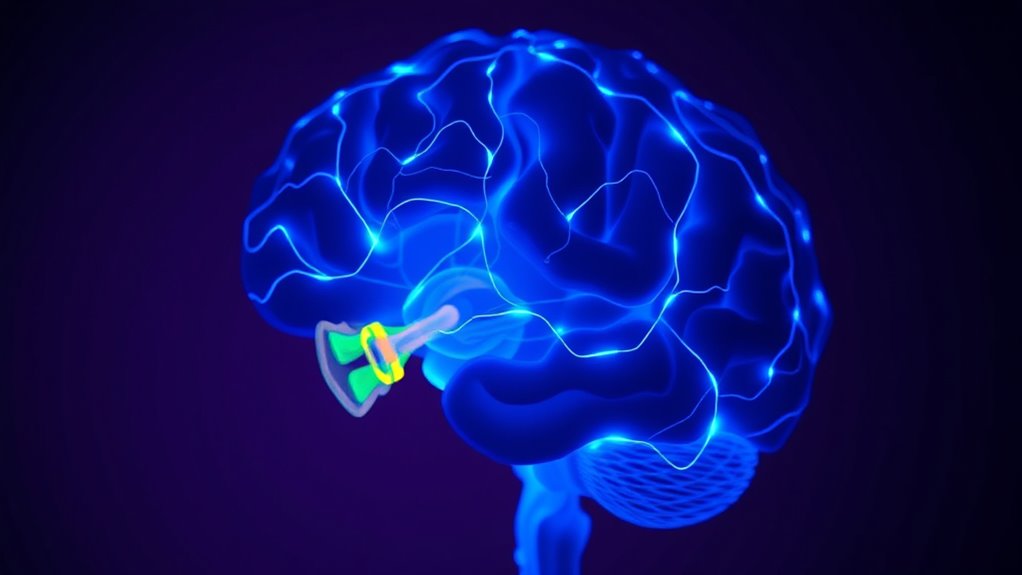Earworms happen because your brain involuntarily repeats catchy melodies through neural pathways involving the auditory cortex, hippocampus, and frontal lobe. These regions reinforce memory traces, especially when songs are emotionally significant or familiar. Repetition and emotional connections make certain tunes stick longer by strengthening neural circuits. Your susceptibility varies based on how your brain processes music and memories. To learn more about how these loops persist and how to reduce them, explore further.
Key Takeaways
- Earworms activate neural pathways in the auditory cortex, hippocampus, and prefrontal cortex, reinforcing the looping of melodies in the brain.
- Repetition and emotional associations strengthen synaptic connections, embedding songs into long-term memory circuits.
- The brain’s pattern recognition and desire for resolution create feedback loops that sustain involuntary musical loops.
- Emotional memories linked to melodies involve the limbic system, increasing their persistence and recurrence.
- Neural mechanisms for memory, emotion, and pattern prediction collectively contribute to the involuntary and persistent nature of earworms.
What Are Earworms and Why Do They Happen?

Have you ever found yourself stuck with a song or a catchy tune looping in your mind? That’s an earworm—a phenomenon rooted in musical nostalgia and your brain’s tendency to replay familiar melodies. These involuntary repetitions are a type of auditory hallucination, where your mind conjures up the tune without any external sound. Earworms tend to happen when a song is particularly catchy or emotionally significant, triggering strong memories or feelings. Your brain forms strong associations with certain melodies, making them easy to recall and difficult to forget. This automatic replay creates that persistent loop, often without your conscious control. Interestingly, home organization techniques can sometimes influence your mental clarity and mood, subtly helping reduce the frequency of these musical intrusions. So, earworms are more than just annoying; they’re a fascinating example of how your brain processes and retains music.
The Brain Regions Involved in Musical Memory

When you listen to a catchy tune, your auditory cortex activates to process the sounds, while your hippocampus helps store the memory of the melody. The frontal lobe is involved in recognizing and predicting musical patterns, keeping the tune looping in your mind. Understanding these brain regions reveals how your brain keeps earworms alive. Notably, the global entertainment industry benefits financially from the popularity of hit songs, with some tunes generating billions in revenue through various streams.
Auditory Cortex Activation
The auditory cortex plays a central role in musical memory by actively processing sounds and melodies that you hear. When a song gets stuck in your head, this region is responsible for recognizing and maintaining the auditory patterns. It’s also involved in auditory processing, helping you differentiate pitches, rhythms, and tones. Sometimes, heightened activity in the auditory cortex can lead to musical hallucinations, where you perceive music that isn’t actually playing. This illustrates how sensitive and powerful this brain region is in shaping your musical experiences. The activation of the auditory cortex during earworms reinforces the memory traces of melodies, making them persist even when you’re not intentionally listening. Overall, this area is essential for transforming sound into meaningful, memorable music in your mind.
Hippocampus Role
Building on the role of the auditory cortex in processing melodies, the hippocampus contributes by linking musical patterns to your memories. Its hippocampal functions are essential for memory encoding, transforming fleeting sounds into lasting impressions. When you hear a catchy tune, your hippocampus helps connect that melody to associated emotions or contexts, making it easier to recall later. This process involves integrating musical features with your existing memory networks. The hippocampus acts as a hub, ensuring that the song becomes part of your personal memory bank. Its involvement explains why certain earworms stick with you—they’re deeply embedded through efficient memory encoding. Additionally, the hippocampus supports neural plasticity, which allows your brain to adapt and strengthen these musical memories over time. Without the hippocampus, retaining and retrieving musical memories would be profoundly impaired, highlighting its critical role in the neuroscience of earworms.
Frontal Lobe Involvement
While the hippocampus helps encode musical memories, the frontal lobes play a crucial role in organizing and retrieving these memories. When you experience an earworm, your frontal lobes work to access stored melodies, but they can also contribute to cognitive interference, making it hard to focus on other tasks. In some cases, this interference leads to musical hallucinations, where the brain perceives the song even without external stimuli. The frontal lobes help suppress irrelevant sounds, but when overwhelmed, they may inadvertently reinforce the loop of the earworm. This involvement explains why certain songs persist stubbornly in your mind, especially during moments of distraction or fatigue, highlighting the delicate balance between memory retrieval and cognitive control in musical recall.
How Songs Get Stuck: The Role of Repetition and Catchiness

When a song repeats in your mind, it strengthens its presence in your memory, making it more likely to stick. Catchy melodies activate specific brain regions, reinforcing their grip on your thoughts. Familiar tunes create a loop, encouraging your brain to keep replaying them effortlessly. Additionally, passive voice can make writing less direct and engaging, so detecting and correcting it helps improve clarity.
Repetition Reinforces Memory
Repetition is a powerful tool that helps songs stick in your mind by strengthening the neural connections associated with their melodies and lyrics. When you hear a song repeatedly, your brain forms robust pathways, making it easier to recall the tune later. This reinforcement can sometimes lead to musical hallucinations or auditory illusions—perceptions of music that seem real but aren’t actually playing. These phenomena occur because your brain’s auditory cortex becomes hyperactive from constant exposure, creating vivid, looping impressions of familiar melodies. The more you hear a song, the more ingrained it becomes in your memory, increasing the likelihood of it looping endlessly in your mind. Repetition fundamentally cements these patterns, making earworms persist long after the music has stopped. Additionally, auditory cortex activity plays a crucial role in how these looping perceptions are generated and sustained within the brain.
Catchy Melodies Activate Brain
Catchy melodies have a powerful ability to activate specific areas of your brain, making songs more likely to get stuck in your mind. When you hear a catchy tune, your brain’s musical perception centers, like the auditory cortex, respond intensely, engaging your cognitive processes. This heightened engagement boosts the likelihood that the melody will resonate deeply, creating a loop in your mind. The repetitive, simple structure of catchy songs triggers neural pathways associated with pleasure and reward, reinforcing their presence in your memory. Your brain’s natural tendency toward pattern recognition makes these melodies particularly easy to recall and replay. Additionally, studies indicate that consistent exposure and exfoliation of musical patterns can strengthen these neural pathways, making earworms even more persistent. As a result, the combination of musical perception and cognitive engagement explains why some tunes become earworms, looping endlessly despite your efforts to forget them.
Familiarity Fuels Looping
Familiarity plays a crucial role in how songs become earworms by making melodies feel more accessible and easier to remember. When you hear a song repeatedly, your brain forms stronger neural connections, increasing its catchiness. This familiarity can even lead to musical hallucinations, where your mind continues to play the tune unconsciously. Auditory illusions often contribute to this looping effect, tricking your brain into perceiving a song as ongoing even after it stops. Repetition reinforces the song’s structure, making it easier to recall and more likely to get stuck. Basically, the more familiar and repetitive a melody, the more it becomes ingrained in your subconscious, fueling that persistent looping of an earworm. Additionally, the use of sound design techniques in creating catchy melodies can enhance their memorability and emotional impact.
The Psychology Behind the Persistence of Earworms

The persistence of earworms often puzzles us because these involuntary tunes seem to loop endlessly in our minds without any conscious effort. Psychologically, they’re linked to our brain’s desire for familiarity and pattern recognition, which keeps the song active in your thoughts. When you experience an earworm, your mind tries to resolve the unresolved, creating a loop that feels hard to break. Engaging in music therapy or using cognitive distraction techniques can help. For example, listening to different music or focusing on a task shifts your attention away from the stuck tune. Your brain naturally seeks closure, and these strategies redirect your focus, reducing the song’s grip. Additionally, recent advances in understanding AI-generated content suggest that personalized interventions could be developed to help manage earworms more effectively. Understanding this psychological mechanism empowers you to manage earworms proactively.
Neural Pathways and the Reinforcement of Musical Loops

Your brain activates specific neural circuits whenever you hear a catchy tune, reinforcing the loop in your memory. These pathways strengthen through repeated exposure, making the song stick even longer. As a result, your brain’s memory mechanisms keep the earworm looping in your mind. Additionally, tuning techniques can influence how strongly these neural pathways are reinforced, further entrenching the earworm.
Neural Circuit Activation
When a catchy tune gets stuck in your head, your brain actively engages specific neural pathways that reinforce the musical loop. These pathways form a circuit that fuels your musical nostalgia and deepens cognitive entrapment. You can think of it as a looped highway in your brain, constantly rerouting signals. Additionally, the brain’s ability to encode and store memories plays a crucial role in solidifying these musical patterns, making the earworm more persistent over time. 1. The auditory cortex processes the melody and lyrics. 2. The limbic system triggers emotional responses linked to nostalgia. 3. The prefrontal cortex keeps the tune active in working memory. 4. The basal ganglia reinforce the loop through repetition. This activation creates a feedback loop, making the earworm persist. The more you hear or think about the song, the stronger and more ingrained these neural circuits become, fueling your desire to replay the tune endlessly.
Memory Reinforcement Mechanisms
Memory reinforcement mechanisms strengthen the musical loops in your brain by engaging specific neural pathways that facilitate repetition and consolidation. When a song triggers musical nostalgia, your brain’s reinforcement pathways become more active, making the tune more likely to loop. This process involves strengthening synaptic connections, which helps embed the song into long-term memory. As a result, the earworm persists, often serving as a cognitive distraction, pulling your focus away from other tasks. Repetition reinforces the neural circuits responsible for the loop, making it harder to forget. These mechanisms explain why certain melodies stick with you, especially those linked to emotional memories or familiar experiences. Ultimately, your brain’s reinforcement pathways cement earworms through repeated activation, turning fleeting tunes into persistent mental loops.
The Impact of Emotions on Earworm Frequency

Emotions play a significant role in how often earworms recur in your mind. When a song triggers strong feelings, it creates emotional resonance that makes the tune more persistent. This is especially true with musical nostalgia, where recalling a song from your past intensifies the experience. To understand this impact, consider:
Strong emotions and nostalgia make earworms stick longer in your mind.
- Positive emotions, like happiness or excitement, often make earworms more frequent.
- Songs linked to emotional memories tend to loop longer in your mind.
- Musical nostalgia heightens emotional resonance, strengthening the earworm’s hold.
- Stress or anxiety can also amplify the recurrence of certain tunes, as your brain seeks comfort or familiarity.
These emotional connections deepen the earworm’s grip, making it harder to forget the song. Your feelings directly influence how often these tunes play on repeat.
Why Some People Are More Prone to Earworms Than Others

Some people are naturally more prone to earworms because of differences in brain structure and cognitive tendencies. You might find yourself more susceptible if you have a vivid capacity for auditory imagery, which allows you to mentally replay sounds or melodies effortlessly. Additionally, musical nostalgia plays a role, as songs that evoke strong emotional memories tend to stick in your mind longer. Your brain’s tendency to fill in gaps through auditory rehearsal can make certain tunes loop repeatedly. People with heightened activity in areas linked to memory and emotion, like the hippocampus and amygdala, are more likely to experience persistent earworms. These neural tendencies make some individuals more vulnerable to songs getting stuck on repeat, especially when they connect to personal memories or trigger emotional responses.
Techniques to Get Rid of Persistent Earworms

When a persistent earworm takes hold, actively engaging your mind with alternative tasks can help break the cycle. Try these techniques:
- Listen to different music or soundscapes—this can shift your focus and replace the earworm.
- Practice sound healing or mindful breathing—these calming techniques reduce mental fixation on the song.
- Engage in a challenging activity like puzzles or learning a new skill, which redirects your attention.
- Use music therapy intentionally—playing or singing a different piece can overwrite the stuck tune.
These methods leverage sound therapy principles to rewire your auditory focus, helping your brain move past the loop. Consistent practice can diminish the song’s grip and restore mental clarity.
The Connection Between Earworms and Brain Disorders

Research indicates that persistent earworms can sometimes signal underlying brain disorders, especially when they occur frequently or resist distraction. Conditions like musical hallucinations may cause you to hear songs that aren’t present, often linked to psychiatric or neurological issues. Auditory agnosia, a disorder impairing sound recognition, might also contribute to abnormal involuntary musical memories. In these cases, earworms aren’t just harmless quirks but symptoms of deeper problems affecting auditory processing or neural networks. If you experience persistent earworms alongside other symptoms like hallucinations or difficulty recognizing sounds, it’s essential to consult a healthcare professional. Recognizing these signs can lead to earlier diagnosis and treatment of potential brain disorders.
Exploring the Evolutionary Roots of Involuntary Musical Memories

The roots of involuntary musical memories likely extend deep into our evolutionary past, serving adaptive functions that helped early humans survive and communicate. These memories foster musical nostalgia, strengthening social bonds and collective identity. Cultural influences shape which melodies become ingrained, making some tunes more prone to looping. Consider these aspects:
Involuntary musical memories reinforce social bonds and cultural identity across human evolution.
- Memory reinforcement: Repeating sounds helped early humans remember crucial information.
- Social cohesion: Shared songs promoted group unity and cooperation.
- Emotional regulation: Music triggers emotional responses, aiding stress relief.
- Cultural transmission: Melodies passed down generations, embedding themselves in collective memory.
Involuntary musical memories, as a result, reflect an evolutionary blend of survival, social, and cultural needs, explaining why certain tunes persist as earworms across ages.
Frequently Asked Questions
Can Earworms Be Used Therapeutically for Mental Health?
You might find that earworms can be harnessed in music therapy to support emotional regulation. When you intentionally select positive or calming songs, these melodies can help manage stress and boost your mood. By using earworms strategically, you can create a mental environment conducive to healing and relaxation, making them a valuable, accessible tool in mental health treatment. This approach leverages natural song loops for therapeutic benefit.
Do Cultural Differences Influence the Frequency of Earworms?
Cultural melodies are like threads weaving through your mind, shaping how often earworms appear. You might find regional tunes more persistent or catchy because they resonate deeply with your background. Different cultures’ musical styles and exposure influence earworm frequency, making certain tunes stick like glue. So, yes, your cultural environment can turn simple melodies into persistent mental loops, echoing your identity and experiences in a way that’s uniquely yours.
How Do Earworms Affect Concentration and Productivity?
Earworms can profoundly impact your concentration and productivity through musical fixation, where a song repeatedly plays in your mind. This cognitive interference distracts you from tasks, making it harder to focus. You might find yourself mentally stuck on the tune, reducing efficiency. To minimize this, try to consciously replace the earworm with a different activity or a different song, helping clear your mind and regain focus.
Are Children More Susceptible to Earworms Than Adults?
Imagine a world where your mind’s a sponge, absorbing every tune like a super magnet. Children are more susceptible to earworms because of their developmental susceptibility and cognitive differences—they process new sounds more intensely and have less mental filtering. This makes catchy melodies stick like glue, looping endlessly in their minds. Adults, with more developed brains, can usually shake off earworms quicker, but kids often carry these musical loops for days.
Can Listening to Certain Music Prevent or Reduce Earworms?
You might find that listening to certain music can prevent or reduce earworms through musical interference, which disrupts the loop. By engaging in cognitive distraction, you shift your focus away from the repetitive tune, making it less likely to stick in your mind. Choose complex or unfamiliar music, as it can effectively interfere with the earworm’s recurrence, helping you regain mental clarity and enjoy your day without constant looping songs.
Conclusion
Now that you understand how earworms latch onto your mind, you might wonder—what’s next? Will they fade away on their own, or is there a deeper reason they keep replaying? As your brain continues to weave these musical loops, the mystery deepens. Stay tuned, because revealing the secrets behind these persistent tunes could reveal more about your mind than you ever imagined. The next note in this mental symphony is waiting to be uncovered.










